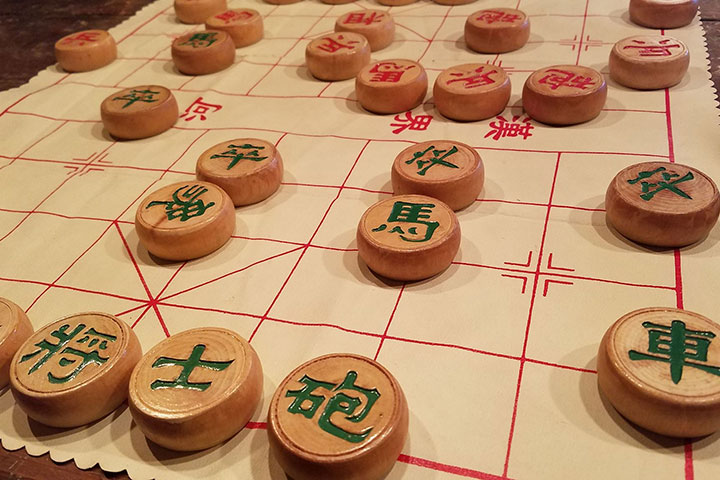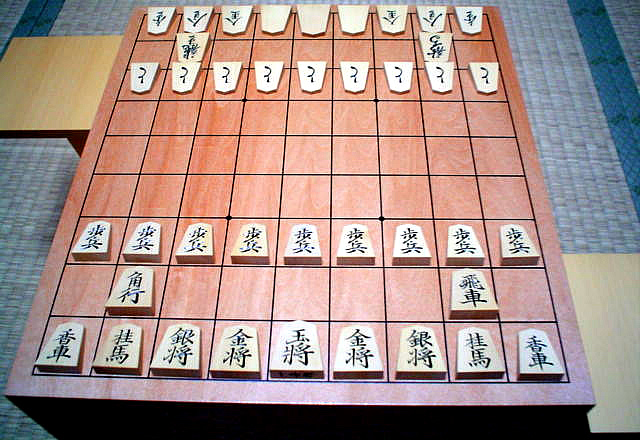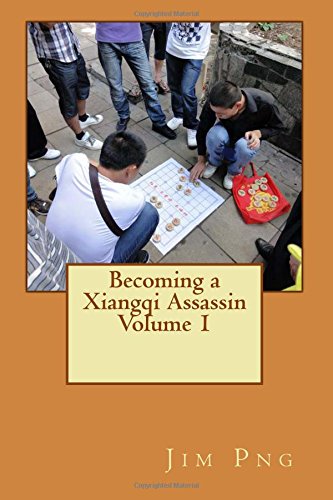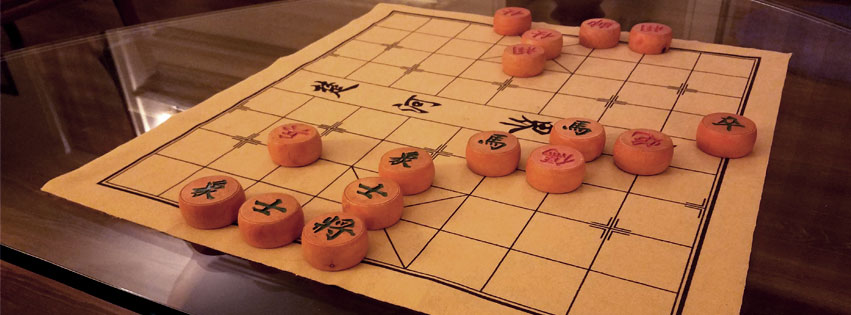


XiangQi are the words used in Chinese language for describing the game also known as Chinese chess. The name is usually translated as "elephant game" or "figure game", and it may have originated as far back as the first century BCE.
Like (Western) chess, the game depicts a battle between two armies, with the aim pursuing the opponents general (or king). XiangQi's unique pieces include the cannon (pao), which must jump to capture; and the board is divided into distinct areas such as the river and the palace, which limit the movement of certain pieces, while enhancing others). Of particular note is the placement of the pieces on the intersections of the board lines, rather than within the squares, much like in Go.
Fabiano Caruana is a fan:
After a long month of chess, time to relax with some Xiangqi https://t.co/26VxeEx2sy
— Fabiano Caruana (@FabianoCaruana) April 24, 2017

The starting position
Recently Magnus Carlsen's second, GM Peter Heine Nielsen, explained to Chessbase India why one should learn Shogi (Japanese Chess).

Shogi has some similarities
Then, I began to realize how the preparation of modern professional chess players — especially those at the top — has reached a new level. Top professionals not only care about their bodies with physical exercise and diet, but also begin to consider other forms of chess played in other countries to keep their interest always high, and their brains always in top shape!
Vassily Ivanchuk is also famous for playing Frisian draughts, which he considers good for learning calculation, particularly as it relates to zugzwang.

Ivanchuk facing checkers champion Michele Borghetti | Source: Marten Walinga on YouTube
In any case, since I'm always looking for ways to improve my chess, I remain open-minded when it comes to adding a new chess-like discipline to my chess training regimen.

Antique Bronze Chinese Chess Set | House of Staunton chessantiques.com
The Chinese have a millennial culture which spans a continent. Their language is extremely exciting, because it is rooted deeply in history, along with tales of a population which is exceptionally good at doing anything they set their minds to. They are perfectionists, true masters of whatever they love.
XiangQi years ago | Photo: xqinenglish.com
In the west unfortunately we know very little about China, apart the usual stereotypes like Bruce Lee, Mao Ze Dong, and probably the Hong Kong triads. But there is an entire universe to explore. For example many years ago I loved to read these book written by a Dutch sinologist, Van Gulik, on this Judge Dee, and his investigations based on ancient China.


Van Gulik, a diplomat, but a Sinologist at heart, enriched the mystery stories with some of his own, but mainly he was just translating documents left from the ancient past, as we might read police and judicial investigations conducted in Ancient Roman times.

Van Gulik loved Chinese culture, and loved to collect ancient artifacts, but unfortunately his collection was lost during the chaos that ensued during the Second World War. Often I imagined how some of these archeological findings helped him gap the bridge of time, and relive with a soul from another historical period.
Why did I introduce Van Gulik? Because he was someone I wished to know, who unfortunately died before I was old enough to have the chance. Van Gulik in my opinion was a very important key to appreciating Chinese culture based on Confucian values, which maybe unclear if one merely read Confucius' classics like The Analects.
Now, thanks to globalization, and the chance to communicate through social apps with people from all over the world, I believe we have another gentle soul, like Van Gulik, but for Chinese Chess. This great man love for XiangQi is phenomenal, and like Van Gulik, he can open the door to an ignorant westerner like me, to one of the most important traditional Chinese rituals, the one of the game of XiangQi.
Jim Png is a surgeon by trade in Taiwan, where he moved there from Singapore. He has translated some of the ancient texts in modern English, and his great work made me want to play XiangQi.

Jim Png at a Chinese Chess conference in Hangzhou, in 2017 | Photos: Jim Png
"The Secret in the Tangerine" is a series of 4 volumes, which were translated from an ancient manual dated around 1600 CE.
"Becoming a Xiangqi Assisin (Volume One)" is an accessible book for those who need to learn to play.


For those who love history like me, there is "Understanding the Elephant Part 1", in which one can discover, and better understand how XiangQi evolved. In the beginning the board was used for divination, likely together with the famous text called I-Ching. Part 2 is more instructional.


I began reading his "Lexicon". I remember last summer at the swimming pool, I had this young friend asking me why I gave so much attention to such a book; she couldn't understand why I read so intensely such masterpiece, compared to, say, the "fascinating" gossip conversation going on nearby.
![]()
To me it was obvious. The reason was simple: my spirit was grasped in a new understanding of what I longed long time before. Previous Chinese-English dictionaries didn't explain the XiangQi terminology, and one couldn't understand what was written in XiangQi books, which has a literature as widespread and as copious as chess books.
Yes, you read right. In China there are some Chinese Chess book collectors who own more than 20,000 XiangQi books! One of them has an entire building in which to keep his Chinese chess books!
I lived in China, and wish I could understand more, but the language and the thousand year culture are quite a barrier. With a Chinese—English dictionary, you can translate common stuff, because when you find one ideogram, you also find what the ideogram is coupled with — ideograms go two-by-two and often hold a different meaning. Unfortunately for XiangQi they can go four-by-four or more! A sequence of ideograms might refer to, say, a situation that happened during a war 1500 years before. This is no trouble for an educated Chinese with knowledge of ancient literature. The meaning is clear — they immediately refer the quotation to its historical contextual origins. But in an everyday dictionary it is impossible to translate, even when if one can find all the ideograms. So the work Jim Png is doing is worthy of Nobel prize in literature; he is translating language no westerner — even a sinologist — could readily comprehend.
But how can XiangQi improve your chess?
It will sharpen your tactical skills from whatever level you are, bringing you to the next level! One of the main differences between Chess and XiangQi are the open files at the beginning of the game, while in chess all the files are closed by pawns. By contrast, in XiangQi there are already four open files, four highways to let our heavy war machines go to their final battle destination.

Thanks to Chris Hankinson for the XiangQi board image above
You have to look far ahead, therefore XiangQi will improve our calculation strength, and add clarity to the final position. In fact in XiangQi there are some important studies, like the "Gathering of the Seven Stars" which are quite complicated, nearly more complicated than anything found in chess!
The starting position of the Gathering of the Seven Stars
The position above is a study which has several hundred of variations and sub-variations. In fact, the first Chinese Chess book in English concerns this particular endgame composition: "A Chinese Chess ending with three-hundred variations" by Charles Kliene, written in Shanghai in 1916. The main lines of this study are generally between 11 and 27 moves long! There are three other studies, with quite choreographic names, that are similar in difficulty to the Gathering of the Seven Stars. But in reality, the beauty of Chinese chess resides in some ancient texts with positions which are not so complicated, yet truly beautiful.

Photo: XiangQi Master Russell Sim Yip How
Yes, this is the real point. When we do a certain activity, connections between neurons in our brains are formed to allow us to better perform in that activity, be it learning a new language, or a new skill. Chess has the same allocated place in the brain that we would have for Chinese Chess, hence we are not damaging one in favor of the other, we are keeping our connections alive, and functioning also when we need a break from chess as sport to avoid over-exertion! Think of it as a localized muscle training.
In chess, thanks to pawns closing the position, many young players just play 20 moves and then offer a draw. In XiangQi you cannot close the position — you have to fight till the end. XiangQi separates the true gladiator from the Sunday sports layman. If your mentality in chess is "live and let's draw", don't try XiangQi, because there are no prisoners in XiangQi. It will hurt you badly!

Often, when we try to solve a position, we can't. So what to do? One of the best things is to let the mind work on it, while we take a little break, and watch something else. With XiangQi, the same applies.
Let's say you are in a period of stagnation with your chess rating, and you cannot improve. Take 15-20 days off, and learn to play XiangQi, solve XiangQi checkmating problems, play everyday few XiangQi games, and then after 15 days go back to chess, and see what happened! (I'm advising this system to club or tournament players, not to those who just began to play chess.) I did a similar experiment with great results. I didn't have tournaments for a couple of weeks, so I began consistently playing XiangQi and solving problems, even played in a XiangQi tournament online, and then returned to chess because in a week a couple of tournaments were coming up. The results were amazing, my creativity was clearly raised, and I didn't play chess for over 2 weeks!
Caruana, Nielsen, Ivanchuk are all top of the world class players, and all of them tried different forms of chess, to improve their calculation skills, and add that little extra which gives them an advantage over the other players. XiangQi can be learned in 10 minutes by a chess player, and can add benefits for visualization and calculation which can give us that edge we need to overcome our opponents! Don't waste this chance to add this exciting form of chess to your training.
| Advertising |